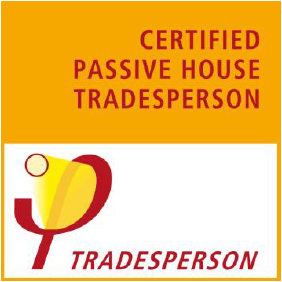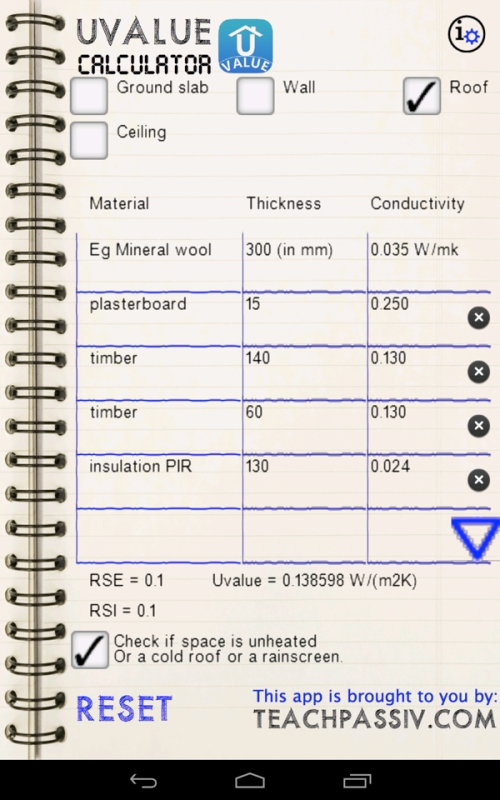News
Post by Mark Stephens Architects on Sequencing
Post HERE by YT on Sequencing and how it applies to good construction and Passivhaus delivery
U Value Calculator now available on iOS, Android & Windows phone!
![]() Finally after months of development and testing, our U value calculator app UValue is released on Apple iOS as well as Android and Windows Phone.
Finally after months of development and testing, our U value calculator app UValue is released on Apple iOS as well as Android and Windows Phone.
Below are a few screen grabs that show the key features:
• Scalable high resolution graphics for all phones and tablets
• Ability to enter your own materials, thicknesses and conductivities as opposed to searching in scrolling lists
• Calculates for floors, walls, roofs and ceilings and adjusts the interior and exterior thermal resistance values accordingly (in accordance with DIN EN 6946 Section 5, Chart 1.)
• Available on Android, iOS & Windows Phones
• Includes settings for underground wall, rain screen or warm/cold roof constructions
• Information/settings screen
• Ability to reset all values or delete individual lines
• Adheres to Passivhaus methodology of calculating U values (excluding thermal bridging – see below)
• Links to TeachPassiv.com and additional Passivhus resources, news & FACT SHEETS
• This version totally free of charge

Screen grab showing main screen with unfilled data

Screen grab of settings/information screen
Why did we create the app? I was looking for a simple U value app that gave the ability of quickly entering data, allowed a quick comparison between different constructions/insulation and supplemented the PHPP U value calculations (the app is not intended to replace PHPP). I found that the app didn’t exist and we (myself and my coding maestro son Conor) decided to fill the gap in the market.
The app is free of charge and is used as a marketing aid for TeachPassiv.com and the architecture and Passivhaus Design Practice Mark Stephens Architects
The app does not currently take account of thermal bridges, this is going to be addressed in a subsequent version.
If you find any bugs or inaccuracies in the app, please do not hesitate to contact us at support@teachpassiv.com
You can read the Privacy Statement regarding the app HERE
The app is not supported or endorsed by the Passivhaus Institute, does not replace the U value calculations in PHPP and is for entertainment purposes only e&oe.
A big shout out to my sons own website who is a Games Coding Guru at GreenCheeseGames.com
Passivhaus Institute announce 2 new certificates to take account of renewables @phplusmag mentioned
The Passive House Institute has announced the launch of two new certification categories, Passive House Plus and Passive House Premium, which recognise on-site renewable energy generation.
Full details in Passive House+ magazine HERE
U value calculator app – Now released on Android #Passivhaus
![]() Finally after months of development and testing, our U value calculator app UValue is released on Android.
Finally after months of development and testing, our U value calculator app UValue is released on Android.
CLICK HERE TO DOWNLOAD THE ANDROID VERSION OF THE APP You can also download the app by clicking on the App icon to the right.
Below are a few screen grabs that show the key features:
• Scalable high resolution graphics for all Android phones and tablets
• Ability to enter your own materials, thicknesses and conductivities as opposed to searching in scrolling lists
• Calculates for floors, walls, roofs and ceilings and adjusts the interior and exterior thermal resistance values accordingly (in accordance with DIN EN 6946 Section 5, Chart 1.)
• This release is on Android, iOS released Easter 2015
• Includes settings for underground wall, rain screen or warm/cold roof constructions
• Information/settings screen
• Ability to reset all values or delete individual lines
• Adheres to Passivhaus methodology of calculating U values (excluding thermal bridging – see below)
• Links to TeachPassiv.com and additional Passivhus resources, news & FACT SHEETS
• This version totally free of charge

Screen grab showing main screen with unfilled data

Screen grab of settings/information screen
Why did we create the app? I was looking for a simple U value app that gave the ability of quickly entering data, allowed a quick comparison between different constructions/insulation and supplemented the PHPP U value calculations (the app is not intended to replace PHPP). I found that the app didn’t exist and we (myself and my coding maestro son Conor) decided to fill the gap in the market.
The app is free of charge and is used as a marketing aid for TeachPassiv.com and the architecture and Passivhaus Design Practice Mark Stephens Architects
The app does not currently take account of thermal bridges, this is going to be addressed in a subsequent version.
If you find any bugs or inaccuracies in the app, please do not hesitate to contact us at support@teachpassiv.com
You can read the Privacy Statement regarding the app HERE
The app is not supported or endorsed by the Passivhaus Institute, does not replace the U value calculations in PHPP and is for entertainment purposes only e&oe.
Does Passivhaus meet the Building Regulations? @phplusmag @BRegsBlog mentioned
I wrote this earlier today on whether Passivhaus meets Part L of Building Regs
I contributed THIS OPINION PIECE to the BregsForum last year concerning Part L compliance of the Building Regulations. In it I said:
“The only way numerically (currently) to assess conformance with Part L of the Building Regulations is via the Dwelling Energy Assessment Procedure (DEAP) software. It is this software that allows the user to input the following:
Property Details
Property Dimensions
Ventilation details (Chimneys, ventilation type, air tightness etc…)
Building elements (Construction types, u values areas etc…)
Water heating
Lighting
The software on completion can give conformity results on U-values, renewables, primary energy use and CO2 emissions. The conformity with the Building Regulations is given in a straightforward green check (tick) or red cross. “
According to a recent article in passive house+ magazine this advice has now been superseded. In the article Dr Brian Motherway, the CEO of Sustainable Energy Authority of Ireland (SEAI) states:
“SEAI does…
View original post 600 more words
All 5 posts from @elrondburrell on #LovePH #Passivhaus
Link below to all 5 posts from Elrond Burrell on ‘What do you love most about Passivhaus?’:
New Fact Sheet on #Passivhaus TEAMWORK! added
A new Fact Sheet on Passivhaus TEAMWORK! has been added to the FACT SHEETS section of website
New fact sheet on #Passivhaus sequencing added…
A new Fact Sheet on Passivhaus Sequencing has been added to the FACT SHEETS section of website
New fact sheet on #Passivhaus TEAMWORK! added…
A new Fact Sheet on Passivhaus Sequencing has been added to the FACT SHEETS section of website
Does solar orientation matter? Blog post by @elrondburrell #Passivhaus
Great blog post by Elrond on whether solar orientation matters for Passivhaus:
New #Passivhaus Fact Sheet on Thermal Conductivity & u values added
Here is link to new Fact Sheet on Thermal Conductivity and u values which has also been added to FACT SHEETS section of website.
This Fact sheet is in response to recent confusion over conductivity values.
Great #Passivhaus Comfort post by @ElrondBurrell #LovePH
Great Post by Elrond Burrell on Passivhaus Comfort:
Sneak peak of new #Passivhaus U-value App
![]() Below is a sneak peak at the ‘in-development’ screen-grab of the forthcoming Passivhaus U-value App:
Below is a sneak peak at the ‘in-development’ screen-grab of the forthcoming Passivhaus U-value App:

We’re in the final stages of testing, all the code is written and is being beta-tested on devices; so far all the calculations for all conditions (where Rse and Rsi are critical) are working OK.
To make sure you receive details on when the app is released (for Apple iOS and Android) subscribe via email in the right hand widget…
New Passivhaus U-Value Calculator App in development…
![]() TeachPassiv.com are please to announce the imminent release of a new Passivhaus App for Apple iOS and Android.
TeachPassiv.com are please to announce the imminent release of a new Passivhaus App for Apple iOS and Android.
The app is a U-value calculator using the Passivhaus methodology; it has been carefully written to ensure that the surface resistance values are in accordance with EN ISO 6946 for all conditions and can also take into account constructions below ground, unheated spaces and compensation for rain screen constructions.
To ensure that you receive details of this imminent release, please follow/subscribe via email (widget on right hand side)…
Passivhaus Masterclass in Scotland: @Mark_J_Siddall @billbutch @PassivhausArch @PassivhausTrust mentioned
The Passivhaus Trust have a Masterclass covering ‘Passivhaus Delivery, ensuring quality and managing risk’ on 5th February 2015.
Full details and book available HERE
Course facilitators include:
• Mark Siddall, LEAP
• Bill Butcher
• Green Building Store and
• Kirsty Maguire
Passivhaus is cheaper than standard build @encraft_uk @Kate_de @phplusmag mentioned
A recent study by Encraft shows that taking into account the whole life cost of a house, Passive House construction is 2-5% lower than traditional construction methods.
CLICK HERE for the article and HERE for the full article.(788kb)
This article concurs with the article posted by Kate de Selincourt last year for Passive House Plus magazine that explains how the perception that Passive House is more expensive has come about.
CLICK HERE for the post & link to article by Kate de Selincourt
It should be remembered that both pieces of research are UK based and that in Ireland (where the Building Regulations are much closer to Passive House standards), the cost saving differential is much greater.
New #Passivhaus Fact sheet added – Passive House Tradesperson course @Target_Zer0 & @passiveacademy mentioned
 A new fact Sheet has been added to the FACT SHEETS section of website
A new fact Sheet has been added to the FACT SHEETS section of website
Or alternatively CLICK HERE to download the Passive House Tradesperson Fact sheet.
Passive House Tradesperson Courses mentioned in the fact sheet are provided by TargetZero and Passive House Academy
TeachPassiv.com 2014 in review
The WordPress.com stats helper monkeys prepared a 2014 annual report for TeachPassiv.com.
Here's an excerpt:
A San Francisco cable car holds 60 people. This blog was viewed about 3,100 times in 2014. If it were a cable car, it would take about 52 trips to carry that many people.
Click here to see the complete report.
ps A good start and hoping to do a lot more next year, stay tuned…
The Passive House explained in Gingerbread & marshmallows
Merry Christmas to all and to get you in the festive spirit, CLICK HERE (or on the image) for the Passivhaus methodology explained in gingerbread & marshmallows from Treehugger.com
Excellent post by @ElrondBurrell ‘On what the Passive House standard is NOT’
Link to excellent post below by Elrond Burrell on what this Passive House standard is NOT:
The International Passive House Conference Programme for 2015 is out
The programme for the 2015 Passive House Conference in Leipzig can be downloaded HERE (1.2Mb) downloads in new window
Passivhaus Primer: Airtightness Guide @BREWatford mentioned
Passivhaus Primer: Airtightness Guide
Click below for excellent guide on:
‘Airtightness and air pressure testing in accordance with the Passivhaus standard‘
From Passivhaus.org.uk
#Passivhaus trickle-down on ‘Standard’ projects
I put this together on MarkStephensArchitects.com last week…
What I’m seeing over the last few years is that even if the client doesn’t go the ‘whole enchilada’ with a certified Passivhaus (I would however highly recommend designing, building and certifying to the Passivhaus standard incidentally); many of the Passivhaus features are becoming incorporated and ‘trickling down’ to the ‘Standard’ project. Namely:
1. High levels of insulation.
 200mm cavity with low conductivity wall tie
200mm cavity with low conductivity wall tie
With the ‘optimal’ cavity width for Passivhaus certification using concrete blocks at 300mm (pumped with platinum multi-bead insulation); we’re frequently adopting cavities on our ‘Standard’ projects of 200mm and 250mm.
2. Minimal Thermal bridges
As you can see in the image above, we are using low conductivity wall ties instead of steel versions.
The photo below also shows the low-conductivity blocks we use in strategic locations to reduce thermal bridging:
 Low conductivity blocks
Low conductivity blocks
3. Triple Glazing
The price for triple glazing in Ireland has reduced…
View original post 222 more words
2 Great #Passivhaus Books @Green_Books @RIBABookshops @passiveacademy mentioned
This was written on ‘Architect’ site yesterday #Passivhaus #Books
As an avid reader of Passivhaus books (actually any books on a variety of subjects); below are two I would heartily recommend to get you started on Passivhaus theory and onto more advance topics.
1. The Passivhaus Handbook by Janet Cotterell and Adam Dadeby

A great primer in everything Passivhaus. Chapters include:
Part One: The how and why of Passivhaus
• What is Passivhaus
• The economics of Passivhaus
• Passivhaus Certification
• Challenges of meeting the Passivhaus standard
• Natural materials,zero carbon and resilience
• Setting up a Passivhaus project
Part Two: Passivhaus projects: a practical guide
• Using PHPP
• Thermal bridges
• Airtightness and sequencing
• Moisture
• Windows
• Ventilation
• Living in a Passivhaus
• Policy change in the UK
The book is extensively Appendixed with a great glossary of terms/units plus notes and resources.
I used this book as part of my revision before…
View original post 167 more words
#Passivhaus Fact Sheet No. 17 – Choosing a Passivhaus Builder @Target_Zer0 @passiveacademy @vikhouse @BePassive mentioned
Fact Sheet No.17 has just been released on ‘How to choose a Passivhaus builder’
This Fact sheet has also been added into the FACT SHEETS section of the website
Minister Damien English “have to get construction right – this time”
More calls for Passivhaus standard to be implemented in Ireland (via BRegs blog)
By Bregs Blog on October 19th 2014
Minister Damien English (pictured above) at Nzeb conference last week called for the passive house standard to be introduced in housing and suggested moves be made by the construction industry to address skills shortage problems in construction. He suggested we could have a lot of jobs associated with new technical standards that we can’t fill unless the industry gets moving to upskill. Link to conference programme here
Minister English, who told the Conference that he had built his own passive house said that …”we have to get construction right – this time“.
He called for higher construction standards so that houses are cheaper to run. He also gave a timely warning that if the construction industry doesn’t upskill “we could have a lot of jobs we cant fill”
In the article in the Journal.ie from 15th October 2014 “Pressure is on to get building, but those in construction need…
View original post 487 more words
How Brussels moved from UK style building regs to making #Passivhaus mandatory; Ireland could do same?
I saw this tweet by @MariaSfyraki recently on the Passivhaustrust website outlining how Brussels have moved from a UK style Building Regulations to mandatory Passivhaus. Is this something Ireland should consider?
Click HERE to open the document
6 posts on Part L, #ThermalModelling #BRegs & #Passivhaus @BRegsBlog mentioned
The following 6 posts are on who should certify Part L compliance, the BER Assessor? Part L compliance with the Building Regulations with regards to Thermal Bridges/Modelling and Thermal Bridging and Passivhaus
1. From the Bregs Blog admin team – 3 Things Design Certifiers should know about certifying Part L
2. My opinion piece on the BRegs Blog – SI.9 and Part L | Are specialist ancillary certifiers needed? Part 1
3. Follow-up Part 2 opinion piece on the BRegs Blog – SI.9 and Part L | Are specialist ancillary certifiers needed? Part 2
4. On MarkStephensArchitects.com – The basics of Part L Thermal Modelling Building Regulation compliance – Part 1
5. On MarkStephensArchitects.com – The basics of Part L Thermal Modelling Building Regulation compliance – Part 2
6. On MarkStephensArchitects.com – The basics of Part L Thermal Modelling Building Regulation compliance & Passivhaus – Part 3
Reminder that a series of Passivhaus Fact Sheets are in the FACT SHEETS section of website and that the above information is specifically related to Ireland and may not apply to other countries.
Disclaimer:
All advice online is remote from the situation and cannot be relied upon as a defence or support – in and of itself – should legal action be taken. Competent legal and building professionals should be asked to advise in Real Life with rights to inspect and issue reports on the matters at hand.
#Passivhaus Fact Sheet 16 – #PHPP Hitting Airtightness Requirements
This Fact Sheet (below) focusses on Airtightness and it’s relevance in PHPP
Fact Sheet No. 16 – PHPP ‘ Airtightness – Hitting the target’ – Click to download pdf (907Kb)
#Passivhaus Fact Sheet 15 – #PHPP Hitting Primary Energy Requirements
This Fact Sheet on ‘Hitting Primary Energy Requirements in PHPP’ was harder to write than that on Space Heating Demand as there’s a lot of variables concerning frequency of use and energy consumption figures; I have however tried to keep it to the single sheet (in line with all the other FACT SHEETS in the FACT SHEETS section and also to provide information for those new to Passivhaus as well as the more experienced practitioners (who I know read the blog and I welcome any corrections from these highly skilled readers). Link below to Fact Sheet No. 15:
Architects can do more than just the pretty bit…
I wrote this on main site on benefits of using architect with Passivhaus experience/training (ahem)…
The writing was on the wall prior to the implementation of the Building Regulation Amendments under S.I.No.9 of 2014 but since April 1st it looks as if the situation will increase…
The situation being my appointment for the design and planning only on projects and the appointment of a another party for the construction drawings and site inspections.
Now I’m happy that if money is tight that I receive a fee for a ‘part-service’ rather than no job at all but on the basis of a couple of recent jobs I feel that it’s important to emphasise that I can do a lot more than just the ‘pretty’ bit involving the design and planning. This is the purpose of this post; to explain what I (as well as other architects) can offer when they are appointed for the ‘full’ service:
I have always said that the best residential projects are…
View original post 272 more words
Fact Sheet No.14 – PHPP Hitting Space Heating Demand for #Passivhaus
This new Fact Sheet (also in FACT SHEETS section of website) gives a few methods of hitting (and bettering) the Passivhaus Space Heating Demand requirements. It focusses on alternative strategies that may not be obvious in addition to improving u-values, airtightness etc…
Fact Sheet No. 14 – PHPP ‘Hitting the target (1-5)’ – Click to download pdf (341Kb)
There will be additional Fact sheets covering other PHPP areas in due course, watch this space…
Fact Sheet 13 – Passivhaus Cavity closers – openings
Fact Sheet 13, focusses on typical detailing of Passivhaus cavity closers at openings:
Fact Sheet No. 13 – Case Study – Cavity Closers (Openings) – Click to download pdf (493Kb)
Again this is included in the FACT SHEETS section of web site
Fact Sheet 12 – Case study on Cavity Closers: @passivhausnews mentioned
Passivhaus Fact Sheet Number 12 which is the second in the case study series focuses on cavity walls and how they are closed at the eaves:
Fact Sheet No. 12 – Case Study – Cavity Closers – Click to download pdf (566Kb)
This fact sheet is also included in the FACT SHEETS section of the web site
#Passivhaus analysis of integrating timber beams into the airtight layer
Interesting document HERE on how timber beams should be integrated into a Passivhaus airtight construction.
Fact Sheet 11 – Case Study 1: Passivhaus Cavity Wall insulation UK/Ireland
Fact Sheet 11, The first of the Case Studies looks at comparisons & differences to Passivhaus cavity wall insulation between UK and Ireland:
Fact Sheet No. 11 – Case Study – Cavity Wall Insulation – Click to download pdf (334Kb)
Again this is included in the FACT SHEETS section of web site
#Passivhaus Fact Sheet No.10 out on Thermal Bridges
Fact Sheet Number 10 is out on Thermal Bridges:
Fact Sheet No. 10 – Thermal Bridges – Click to download pdf (321Kb)
Again this is included in the FACT SHEETS section of web site
#Passivhaus professionals reach over 4000 in world ! via @phplusmag
If there’s any evidence that Passivhaus is not a fad is that the number of Certified Passivhaus Designers/Consultants (of which Mark Stephens Architects are one) now reaches over 4000 as reported by Passive House + Magazine
For the full article and details CLICK HERE
Fact Sheet No. 9 – Enerphit for Passivhaus retrofitting projects is out!
The latest Passivhaus Fact Sheet (No. 9) on the Passivhaus Enerphit Standard (276Kb) is ready to DOWNLOAD
Again this is included in the FACT SHEETS section of web site
Passivhaus Fact Sheet No. 8 out – Building Certification ( @ElrondBurrell mentioned again!)
Fact Sheet Number 8 on Passivhaus Building Certification is out:
Fact Sheet No. 8 – Building Certification – Click to download pdf (290Kb)
Again this is included in the FACT SHEETS section of web site
Fact Sheet No. 7 on why you need MHVR is out
Fact Sheet No.7 Why MHVR? is out (and also in the Fact Sheets section of website
Excellent post by @ElrondBurrell on why #Passivhaus certification is essential
Excellent post by @ElrondBurrell on why #Passivhaus certification is essential, below:
Fact Sheet No.6 is out – Why do you need triple glazed windows for #Passivhaus? @Green_Books mentioned
Fact sheet No. 6 is out and as promised it’s getting more technical, the sheet refers back to previous posts on this subject on MarkStephensArchitects.com and if you like your physics & maths there are some example calculations given.
CLICK HERE TO ACCESS FACT SHEET NO. 6 – WHY TRIPLE GLAZED WINDOWS?
Any errors on the maths let me know, I remember there were some discrepancies over location irradiation figures.
This Fact Sheet is also included in the Fact Sheets section of the website
#Passivhaus and Ironman Triathlon – the connection @WolfgangFeist mentioned
I wrote this over weekend about Passivhaus, Ironman Triathlon and the bustup between Phi and PHUS
What possible connection could there be between the Passivhaus methodology and Triathlon?
If you’re in the Passivhaus world then you couldn’t help but notice the split between The Passive House Institute based in Germany and the Passive House Institute US. I’m not going into the reasons behind the split (of which there’s stacks on the web) but splits of this type are not unusual and this split is still rumbling on. Even today this Twitter stream shows a Twitter ‘fight’ on this very subject. And here’s the original [POST] that kicked everything off.
Here’s the ‘Open letter’ from Wolfgang Feist on the subject
So, the triathlon analogy…
As a primer, here’s the Wikipedia entry on Ironman Triathlon
Notice the key line:
“Other races exist that are of the same distance as an Ironman triathlon but are not produced, owned, or licensed by the World Triathlon Corporation. Such races include…
View original post 219 more words
Fact Sheet No.5 Ready – Passivhaus Construction
We’ve added Fact Sheet No.5 on Passivhaus Construction to the FACT SHEETS section.
Now that’s the ‘Fundamentals’ dealt with, it’s time to get technical…
Fact Sheet No.4 on Passivhaus design is out: @ParsonsWhittley @zowark featured
Fact Sheet Number 4 on Passivhaus Design is out, next one will be on Passivhaus construction…
CLICK HERE TO DOWNLOAD THE FACT SHEET ON PASSIVHAUS DESIGN (1Mb)
Special thanks to:
Zeno Winkens for
Clauson House Co. Wexford, Winkens Architecture
Isover Energy Efficiency Award 2013 WINNER
Finalist Irish Building and Design Awards Sustainable/Green Project of the Year 2014
Finalist The Green Residential Building Green Awards 2013
http://www.winkens.ie/lownrghse.htm
and
Chris Parsons of Parsons + Whittley Architects for the 3 dwellings at Burnham Overy Staithe for Hastoe
You can download the Fact sheet HERE or via the FACT SHEETS section where you can download the previous sheets.
How to complete all your CPD in one hit: #Passivhaus
Here’s the earlier #Passivhaus CPD post
CPD or Continuing Professional Development is part and parcel of the architects duties and responsibilities and is summarised by the RIAI below:
“The systematic maintenance, improvement and broadening of knowledge and skill and the development of personal qualities necessary for the execution of professional and technical duties throughout the practitioner’s working life”.
The required CPD for Irish architects is 20 hours unstructured work and 20 hours structured work and my approach to completing it has varied from year to year. Some years I’ve knocked off each hour one at a time in approved seminars whilst other years I’ve completed the hours in one hit by completing a bigger course – the RIAI Conservation course is one example of this.
This year has also been a ‘one-hit’ year where all of the years CPD was completed in a single course – the Certified Passivhaus Consultant/Designer course and exam which was completed…
View original post 36 more words
TeachPassiv #Passivhaus Fact Sheet No. 3 out: The Passivhaus Design Team
Fact sheet No. 3 out now: The Passivhaus Design Team
Details who you should appoint and why to build your ultra-low energy Passivhaus.




















